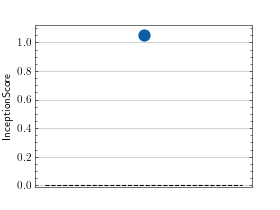Inception Score¶
Module Interface¶
- class torchmetrics.image.inception.InceptionScore(feature='logits_unbiased', splits=10, normalize=False, **kwargs)[source]¶
Calculate the Inception Score (IS) which is used to access how realistic generated images are.
\[IS = exp(\mathbb{E}_x KL(p(y | x ) || p(y)))\]where \(KL(p(y | x) || p(y))\) is the KL divergence between the conditional distribution \(p(y|x)\) and the marginal distribution \(p(y)\). Both the conditional and marginal distribution is calculated from features extracted from the images. The score is calculated on random splits of the images such that both a mean and standard deviation of the score are returned. The metric was originally proposed in inception ref1.
Using the default feature extraction (Inception v3 using the original weights from inception ref2), the input is expected to be mini-batches of 3-channel RGB images of shape
(3xHxW). If argumentnormalizeisTrueimages are expected to be dtypefloatand have values in the[0,1]range, else ifnormalizeis set toFalseimages are expected to have dtype uint8 and take values in the[0, 255]range. All images will be resized to 299 x 299 which is the size of the original training data.Hint
Using this metric with the default feature extractor requires that
torch-fidelityis installed. Either install aspip install torchmetrics[image]orpip install torch-fidelityAs input to
forwardandupdatethe metric accepts the following inputimgs(Tensor): tensor with images feed to the feature extractor
As output of forward and compute the metric returns the following output
inception_mean(Tensor): float scalar tensor with mean inception score over subsetsinception_std(Tensor): float scalar tensor with standard deviation of inception score over subsets
- Parameters:
feature¶ (
Union[str,int,Module]) –Either an str, integer or
nn.Module:an str or integer will indicate the inceptionv3 feature layer to choose. Can be one of the following: ‘logits_unbiased’, 64, 192, 768, 2048
an
nn.Modulefor using a custom feature extractor. Expects that its forward method returns an(N,d)matrix whereNis the batch size anddis the feature size.
splits¶ (
int) – integer determining how many splits the inception score calculation should be split amongkwargs¶ (
Any) – Additional keyword arguments, see Advanced metric settings for more info.
- Raises:
ValueError – If
featureis set to anstrorintandtorch-fidelityis not installedValueError – If
featureis set to anstrorintand not one of('logits_unbiased', 64, 192, 768, 2048)TypeError – If
featureis not anstr,intortorch.nn.Module
Example
>>> from torch import rand >>> from torchmetrics.image.inception import InceptionScore >>> inception = InceptionScore() >>> # generate some images >>> imgs = torch.randint(0, 255, (100, 3, 299, 299), dtype=torch.uint8) >>> inception.update(imgs) >>> inception.compute() (tensor(1.0549), tensor(0.0121))
- plot(val=None, ax=None)[source]¶
Plot a single or multiple values from the metric.
- Parameters:
val¶ (
Union[Tensor,Sequence[Tensor],None]) – Either a single result from calling metric.forward or metric.compute or a list of these results. If no value is provided, will automatically call metric.compute and plot that result.ax¶ (
Optional[Axes]) – An matplotlib axis object. If provided will add plot to that axis
- Return type:
- Returns:
Figure and Axes object
- Raises:
ModuleNotFoundError – If matplotlib is not installed
>>> # Example plotting a single value >>> import torch >>> from torchmetrics.image.inception import InceptionScore >>> metric = InceptionScore() >>> metric.update(torch.randint(0, 255, (50, 3, 299, 299), dtype=torch.uint8)) >>> fig_, ax_ = metric.plot() # the returned plot only shows the mean value by default

>>> # Example plotting multiple values >>> import torch >>> from torchmetrics.image.inception import InceptionScore >>> metric = InceptionScore() >>> values = [ ] >>> for _ in range(3): ... # we index by 0 such that only the mean value is plotted ... values.append(metric(torch.randint(0, 255, (50, 3, 299, 299), dtype=torch.uint8))[0]) >>> fig_, ax_ = metric.plot(values)

